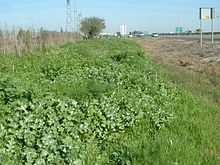Ruderal species

A ruderal species is a plant species that is first to colonize disturbed lands. The disturbance may be natural – for example, wildfires or avalanches – or a consequence of human activity, such as construction (of roads, of buildings, mining, etc.) or agriculture (abandoned fields, irrigation, etc.).
The word ruderal comes from the Latin rudus rubble.
Ruderal species typically dominate the disturbed area for a few years, gradually losing the competition to other native species. However, in extreme disturbance circumstances, such as when the natural topsoil is covered with a foreign substance, a single-species ruderal community may become permanently established, as depicted in the image on the right. In addition, some ruderal invasive species may have such a competitive advantage over the native species that they, too, may permanently prevent a disturbed area from returning to its original state despite natural topsoil.
Features
Features contributing to a species' success as ruderal are:
- Massive seed production.
- Seedlings whose nutritional requirements are modest.
- Fast-growing roots.
- Independence of mycorrhizae.
Quantification
Various scales for quantifying ruderality have been devised.[1]
See also

- Edge effect
- Hemeroby
- Restoration ecology
- Pioneer species
- Supertramp (ecology)
- Examples of ruderal species:
- Conyza bonariensis (family Asteraceae)
- Dittrichia viscosa (Asteraceae)
- Nicotiana glauca (Solanaceae)
References
- ↑ Hill, M.O.; Roy, D.B.; Thompson, K. (2002). "Hemeroby, urbanity and ruderality: bioindicators of disturbance and human impact". Journal of Applied Ecology 39 (5): 708–720. doi:10.1046/j.1365-2664.2002.00746.x.
External links
- St. John TV. 1987. SOIL DISTURBANCE AND THE MINERAL NUTRITION OF NATIVE PLANTS in Proceedings of the 2nd Native Plant Revegetation Symposium
- Chapin. FS. III. 1980. The mineral nutrition of wild plants. Ann. Rev. Ecol. System, 11:233-260.
- Ruderal in the 1911 Britannica
 Media related to Ruderal communities at Wikimedia Commons
Media related to Ruderal communities at Wikimedia Commons